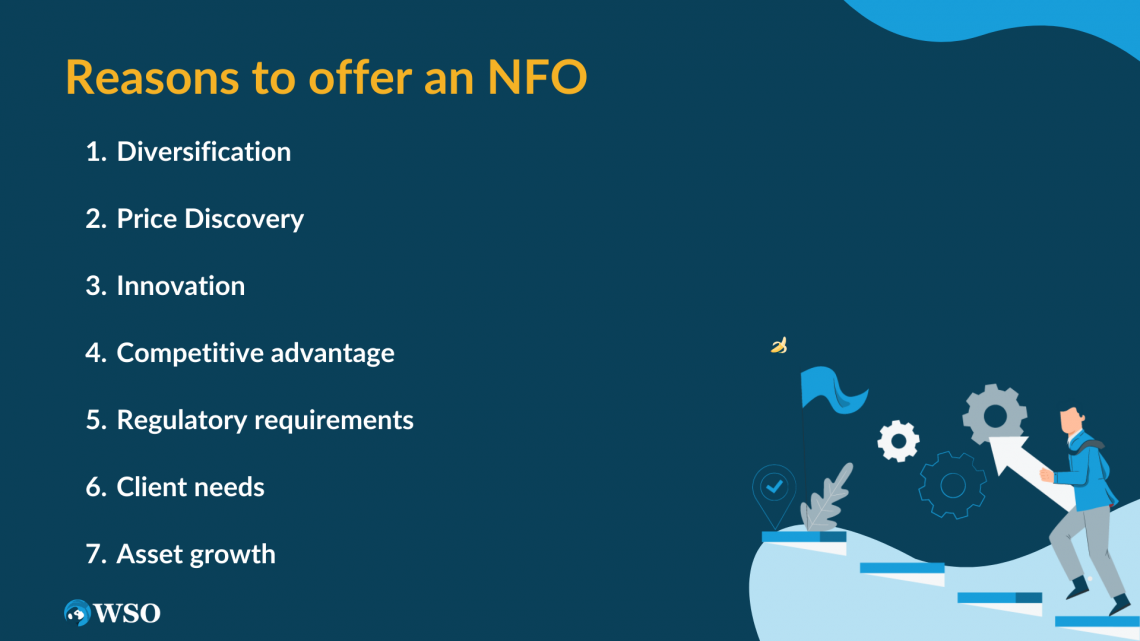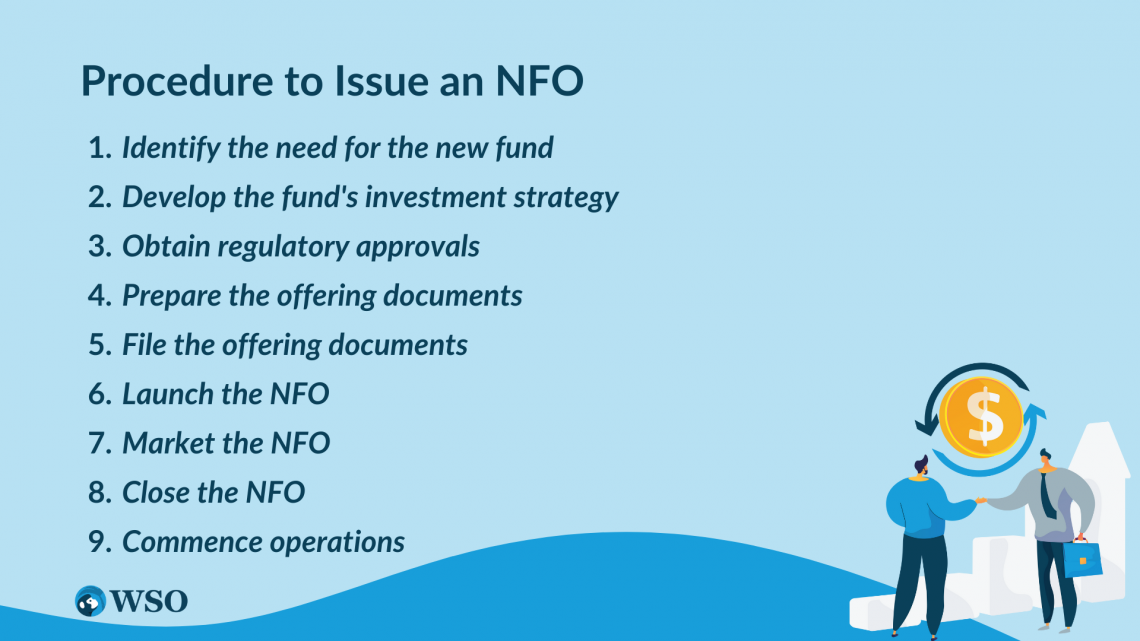NFO
It is a procedure by which a mutual fund or exchange-traded fund (ETF) issues units for the first time to the public for subscription.
A New Fund Offering (NFO) is a procedure by which a mutual fund or exchange-traded fund (ETF) issues units for the first time to the public for subscription. The primary objective of an NFO is to raise capital for a new mutual fund or ETF, much like an IPO on the stock market.

The initial launch phase of a fund, called the NFO period, lasts for a few days to a few weeks, and during this phase, investors can buy units at the offer price. Post the NFO period fund gets listed on stock exchanges, and units are available for purchase and redemption at the going market rate.
The capital raised during this round is then invested in various assets such as stocks, bonds, and money market instruments, depending on the fund's investment objectives.
Investing in a new fund might be dangerous because the mutual fund has no performance history or track record. Yet, some investors favor new funds because they allow them to participate in a new fund when it is still in its early stages, potentially offering them a return edge.
It's crucial to carefully analyze the fund's investment objectives and risk tolerance and, if relevant, the fund manager's historical performance before investing in a new fund.
NOTE
To ascertain if the fund aligns with its investment objectives and risk tolerance, investors should consider its portfolio composition and the fund manager's investing approach.
Reasons to offer an NFO
There can be several reasons for offering a new fund, including

1. Diversification
Launching a new fund enables investors to diversify their portfolios and invest across various asset classes or investing philosophies. This can help reduce risk and potentially improve returns.
2. Market demand
A new fund may be established to satisfy the high demand for a certain form of investment and give investors access to the asset class or investing strategy they desire.
3. Innovation
A new fund can be created to offer investors access to innovative investment strategies or technologies that were previously unavailable.
Creating a new fund can help asset managers differentiate themselves from their competitors and attract new investors. This can be especially important in a crowded market where many similar funds compete for the same investors.
For instance, an asset manager may establish a brand-new fund that invests in a specialized market sector or has a distinctive investing approach from other funds. By doing so, the asset manager can attract investors specifically interested in that niche or strategy rather than being served by existing funds.
5. Regulatory requirements
Asset managers could be obliged to form new funds to comply with new rules or modify current regulations. For instance, new laws in some nations may mandate that funds invest in particular asset classes or employ specified investment methods.
NOTE
In rare circumstances, regulatory bodies may demand that new funds be created to satisfy particular investor protection needs.
6. Client needs
Clients may have unique investment needs or objectives not currently being met by existing funds, prompting the creation of a new fund to meet those needs.
For example, suppose the asset management company receives feedback from its clients that they are looking for an investment option that provides exposure to a particular sector, geographic region, or investment strategy. As a result, the company may launch a new fund to meet those requirements.
7. Asset growth
By launching a new fund, the asset management company can potentially attract new investors and increase its assets under management (AUM), which can help generate additional management and performance fees.
The asset management business may also have the chance to enter new markets or asset classes by creating a new fund, which may help diversify its revenue sources and lessen its reliance on any one fund or investing strategy.
Procedure to Issue an NFO
The procedure to offer a new fund, including a new fund offering, can vary depending on the jurisdiction and the regulatory requirements.

However, here are some general steps an asset management company may need to take to launch a new fund offering
- Identify the need for the new fund
The asset management company should determine the investment strategy and objectives of the new fund and ensure market demand for the fund. - Develop the fund's investment strategy
The asset management company should develop the investment strategy, including asset allocation, investment process, and risk management procedures. - Obtain regulatory approvals
The asset management company should obtain regulatory approvals from the relevant authorities to launch the new fund. The regulatory requirements can vary depending on the jurisdiction, and the asset management company should ensure that it complies with all the applicable regulations. - Prepare the offering documents
The asset management company should prepare the offering documents, including the prospectus, additional information statement, and application form. - File the offering documents
The asset management company should file the offering documents with the regulatory authorities and obtain their approval. - Launch the NFO
Once the regulatory approvals are obtained, and the offering documents are filed, the asset management company can launch the new fund and begin accepting investments. - Market the NFO
The asset management company should market the new fund to potential investors using various channels, including advertisements, email campaigns, and roadshows. - Close the NFO
The asset management company should close the new fund once the fundraising target is met or at the end of the specified subscription period. - Commence operations
Once the new fund offering is closed, the asset management company can commence operation012.s and invest the funds per the fund's investment strategy and objectives.
NOTE
The procedure to offer a new fund offering can be complex, and asset management companies should seek professional advice to ensure that it complies with all the applicable regulations and requirements.
Advantages of Offering a New Fund
There are several advantages of a new fund offering for the asset management company and the investors:

- Opportunity to invest in new strategies
New funds allow investors to invest in new strategies and themes that may not be available in existing funds. - Lower entry cost
NFOs typically have a lower entry cost than existing funds, making them accessible to a wider range of investors. This allows investors to invest in a new fund with a smaller initial investment. - Potential for higher returns
NFOs may offer higher potential returns than existing funds as they invest in new and emerging opportunities, allowing investors to generate high returns over the long term. - Flexibility in investment options
NFOs offer investors the flexibility to invest in various investment options, such as equity, debt, hybrid, and sector-specific funds, depending on their investment objectives and risk appetite. - Improved transparency
To increase openness and aid investors in making wise investment choices, new fund offerings must fully disclose their investment objectives, methods, and risks in the offer document. - Cost-effectiveness
NFOs typically have lower expense ratios compared to existing funds, which can result in cost savings for investors over the long term. - Tax efficiency
NFOs can be tax-efficient for investors as they may offer opportunities for tax benefits and deductions.
Disadvantages of Offering a New Fund
A new fund offering has several benefits, but investors should also be aware of possible drawbacks.

Following are some of the key drawbacks of offering a new fund.
- Lack of track record
NFOs are new funds with no track record, making it difficult for investors to assess their performance and risk-return profile. - Higher-risk
New funds may invest in new and untested strategies or themes, which can be riskier than established funds. This may raise the likelihood of increased volatility and losses, particularly in the fund's early years. - Limited investment options
New funds may offer limited investment options compared to existing funds, which may not align with some investors' investment objectives and risk appetite. - Lack of liquidity
New funds may initially need more liquidity, making it challenging for investors to acquire or sell their interests. This can be especially challenging for investors who need to access their investments quickly. - Higher expenses
New fund offerings may have higher expenses compared to established funds, as the asset management company needs to cover the costs of launching and promoting the fund. - Potential for mis-selling
NFOs may be marketed aggressively by asset management firms, leading to mis-selling and misrepresenting the fund's performance and risks.
This is particularly difficult for investors without the information or experience to assess the fund's performance and hazards.
New Fund Offering (NFO) FAQs

An IPO is used by businesses to generate cash by selling shares to the general public. In contrast, asset management firms use an NFO to introduce new mutual funds or investment plans.
Also, the proceeds from an NFO are invested in securities or other assets in accordance with the investment strategy of the fund, as opposed to an IPO, where the money is frequently utilized to support a company's operations or for other commercial purposes.
New funds can offer an opportunity to invest in a fund with a new investment objective, strategy, or theme not currently available.
However, investing in a new fund can be riskier than investing in an established mutual fund. Moreover, its future success is questionable because it is a brand-new fund with no prior performance history.
So, it's crucial to conduct your study and comprehend the fund's investment purpose, strategy, and prior performance of the fund house before investing in an NFO.
The top 5 biggest fund houses in the world (as of 2022) are:
- BlackRock (USD 9.5 billion under management).
- Vanguard Group (USD 8.1 billion under management).
- UBS Group (USD 4.3 billion under management).
- Fidelity Investments (USD 4.2 billion under management).
- State Street Global Advisors (USD 4 billion under management).




or Want to Sign up with your social account?